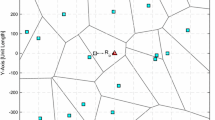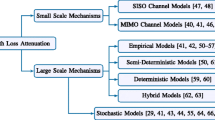Abstract
The aim of the present paper is to show that stochastic geometry provides an efficient computational framework allowing one to predict geometrical characteristics of large CDMA networks such as coverage or soft-handoff level. The general idea consists in representing the location of antennas and/or mobile stations as realizations of stochastic point processes in the plane within a simple parametric class, which takes into account the irregularities of antenna/mobile patterns in a statistical way. This approach leads to new formulas and simulation schemes allowing one to compute/estimate the spatial averages of these local characteristics in function of the model parameters (density of antennas or mobiles, law of emission power, fading law etc.) and to perform various parametric optimizations.
Similar content being viewed by others
References
F. Baccelli and B. Błaszczyszyn, On a coverage process ranging from the Boolean model to the Poisson Voronoi tessellation, with applications to wireless communications, Advances in Applied Probability 33 (2001) 293–323.
T.M. Cover and J.A. Thomas, Elements of Information Theory (Wiley, New York, 1991).
U. Ehrenberger and K. Leibnitz, Impact of clustered traffic distributions in CDMA radio network planning, in: Teletraffic Engineering in a Competitive World, eds. P. Key and D. Smith (Elsevier, Amsterdam, 1999) pp. 129–138.
J. Gubner, Computation of shot-noise probability distributions and densities, SIAM Journal on Computing 17 (1996) 750–761.
P. Gupta and P.R. Kumar, The capacity of wireless networks, IEEE Transactions on Information Theory, IT-46(2) (March 2000) 388–404.
P. Hall, Introduction to the Theory of Coverage Processes (Wiley, New York, 1988).
L. Heinrich and I.S. Molchanov, Some limit theorems for extremal and union shot-noise processes, Mathematische Nachrichten 168 (1994) 139–159.
L. Heinrich and V. Schmidt, Normal convergence of multidimensional shot noise and rates of this convergence, Advances in Applied Probability 17 (1985) 709–730.
W.S. Kendall and E. Thönnes, Perfect simulation in stochastic geometry, Pattern Recognition, Special issue on random sets 32(9) (1999) 1569–1586.
J. Møller, Lectures on random Voronoi tesselations, Lecture Notes in Statistics, Vol. 87 (Springer-Verlag, 1994).
R. Prasad and T. Ojanperä, An overview of CDMA evolution toward wideband CDMA, IEEE Communications Surveys 1 (1998) 2–29 http://www.comsoc.org/pubs/surveys
J.G. Propp and D.B. Wilson, Exact sampling with coupled Markov chains and applications to statistical mechanics, Random Structures and Algorithms 6 (1996) 223–252.
J. Rice, On a generalized shot noise, Advances in Applied Probability 17 (1977) 709–730.
M. Rupf and J.L. Massey, Optimum sequence multisets for synchronous code-division multiple-access channels, IEEE Transactions on Information Theory 40 (1994) 1261–1266.
D. Stoyan, W. Kendall and J. Mecke, Stochastic Geometry and its Applications (Wiley, Chichester, 1995).
F. Tournois, Perfect simulation of a stochastic model for CDMA coverage, INRIA report, 4348 (2002).
V. Veeravalli and A. Sendonaris, The coverage–capacity tradeoff in cellular CDMA systems, IEEE Transactions on Vehicular Technology 48 (2002) 1443–1451.
P. Viswanath and V. Anantharam, Optimal sequences and sum capacity of synchronous CDMA systems, IEEE Transactions on Information Theory 45 (1999) 1984–1991.
S. Verdú, Capacity region of Gaussian CDMA channels: The symbol-synchronous case, in: Proccedings of the 24th Allerton Conference (1986) pp. 1025–1034.
A. Viterbi and A. Viterbi, Erlang capacity of a power controlled CDMA system, IEEE Journal on Selected Areas in Communications 11(6) (August 1993) 892–900.
M. Westcott, On the existence of a generalized shot-noise process, in: Studies in Probability and Statistics. Papers in Honour of Edwin J.G. Pitman, ed. E.J. Williams (North-Holland, Amsterdam, 1976) pp. 73–88.
Author information
Authors and Affiliations
Rights and permissions
About this article
Cite this article
Baccelli, F., Błaszczyszyn, B. & Tournois, F. Spatial Averages of Coverage Characteristics in Large CDMA Networks. Wireless Networks 8, 569–586 (2002). https://doi.org/10.1023/A:1020321501945
Issue Date:
DOI: https://doi.org/10.1023/A:1020321501945




